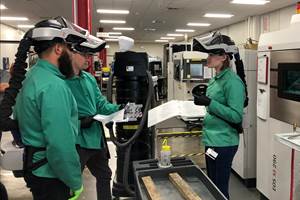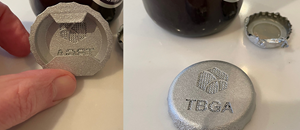Video: Where Does Additive Manufacturing Make Sense?
Can 3D printing produce a useful, functional part? The answer is, unequivocally, yes. Editors discuss where and when AM makes sense in this video.
Share
3D printing is becoming a proven and valid manufacturing process, but is it the best tool for the job? The answer depends on both the part itself and the production constraints.
In this video, Peter Zelinski and I discuss specific scenarios in which additive manufacturing makes sense. Watch below, or read on for the transcript.
Transcript
Stephanie Hendrixson
I'm Stephanie Hendrixson, senior editor with Additive Manufacturing magazine. I'm here with Pete Zelinski.
Pete, you and I work in the additive space and there are a couple of questions that we encounter pretty frequently:
Is additive manufacturing the same as 3D printing?
Peter Zelinski
Additive manufacturing is the approach to manufacturing that has 3D printing at its heart. If I am 3D printing, I am not necessarily manufacturing, and additive manufacturing begins with 3D printing, but it includes more than that. So ultimately, these are different terms and the difference is significant.
Stephanie Hendrixson
Are 3D-printed parts as good as those made through injection molding or machining or some other type of conventional technology?
Peter Zelinski
It depends. If what you want is a near-net-shape part, 3D printing is better. It will get you nearer to net shape than casting or forging will.
I think you're asking a question that's more fundamental than that: Can 3D printing produce a useful, functional part? The answer is, unequivocally, yes. Additive manufacturing is an option that's on the table now for making a tool or making an end-use production part.
Stephanie Hendrixson
In what situations does additive make the most sense?
Peter Zelinski
The reason to use additive often has to do with realizing a geometrically intricate form that you couldn't get any other way, and then there are all these other reasons to use additive as well. So help me out—let's rattle off use cases for additive:
Consolidating an assembly. Take a component that's formerly an intricate assembly of lots of little pieces and just 3D print that as a single complex part.
Stephanie Hendrixson
Lightweighting, the ability to place the material only where you need it, to fill a solid form with a lattice structure, and not carry that extra weight.
Peter Zelinski
Conformal cooling, particularly in molds. Don't have straight drilled holes for cooling but instead grow the cooling channels internally to follow the contours of the form.
Stephanie Hendrixson
Low volumes of parts. If you only need one or 50 or 100 of something, maybe you can 3D print it instead of putting that investment into a mold.
Peter Zelinski
Making tools. A tool is often a one-off part that's got a lot of complexity in it, and commands a lot of lead time. Make that tool additively.
Stephanie Hendrixson
Customization, when you have a product that requires some level of personalization. Maybe it's a medical implant and you want to make it the exact right size for that patient.
Peter Zelinski
Topology optimization. Allow software to grow a part form digitally based on the loads that it requires so that you use only the mass and material needed.
Stephanie Hendrixson
Repair applications. If you have a part that has seen a lot of wear, you can rebuild the portion of it that’s missing.
Peter Zelinski
I think there's another way to face this question as well: The best use of additive ultimately is to realize a shape, a form that you didn't think you could make or solve a problem that you didn't know you had.
So what's the place for additive? The place for additive is at the beginning of the conversation, at the beginning of the design process.
Related Content
10 Important Developments in Additive Manufacturing Seen at Formnext 2022 (Includes Video)
The leading trade show dedicated to the advance of industrial 3D printing returned to the scale and energy not seen since before the pandemic. More ceramics, fewer supports structures and finding opportunities in wavelengths — these are just some of the AM advances notable at the show this year.
Read More3D Printing with Plastic Pellets – What You Need to Know
A few 3D printers today are capable of working directly with resin pellets for feedstock. That brings extreme flexibility in material options, but also requires greater knowledge of how to best process any given resin. Here’s how FGF machine maker JuggerBot 3D addresses both the printing technology and the process know-how.
Read MoreHow to Pursue a Career in Additive Manufacturing
AM professionals are in demand as 3D printing matures and advances. But what skills are hiring manufacturers looking for? How can applicants prepare? And where can you find relevant job listings?
Read MoreA Framework for Qualifying Additively Manufactured Parts
A framework developed by The Barnes Global Advisors illustrates considerations and steps for qualifying additively manufactured parts, using an example familiar to those in AM: the 3D printed bottle opener.
Read MoreRead Next
Hybrid Additive Manufacturing Machine Tools Continue to Make Gains (Includes Video)
The hybrid machine tool is an idea that continues to advance. Two important developments of recent years expand the possibilities for this platform.
Read More4 Ways the Education and Training Challenge Is Different for Additive Manufacturing
The advance of additive manufacturing means we need more professionals educated in AM technology.
Read More3D Printing Brings Sustainability, Accessibility to Glass Manufacturing
Australian startup Maple Glass Printing has developed a process for extruding glass into artwork, lab implements and architectural elements. Along the way, the company has also found more efficient ways of recycling this material.
Read More
.jpg;width=70;height=70;mode=crop)




















